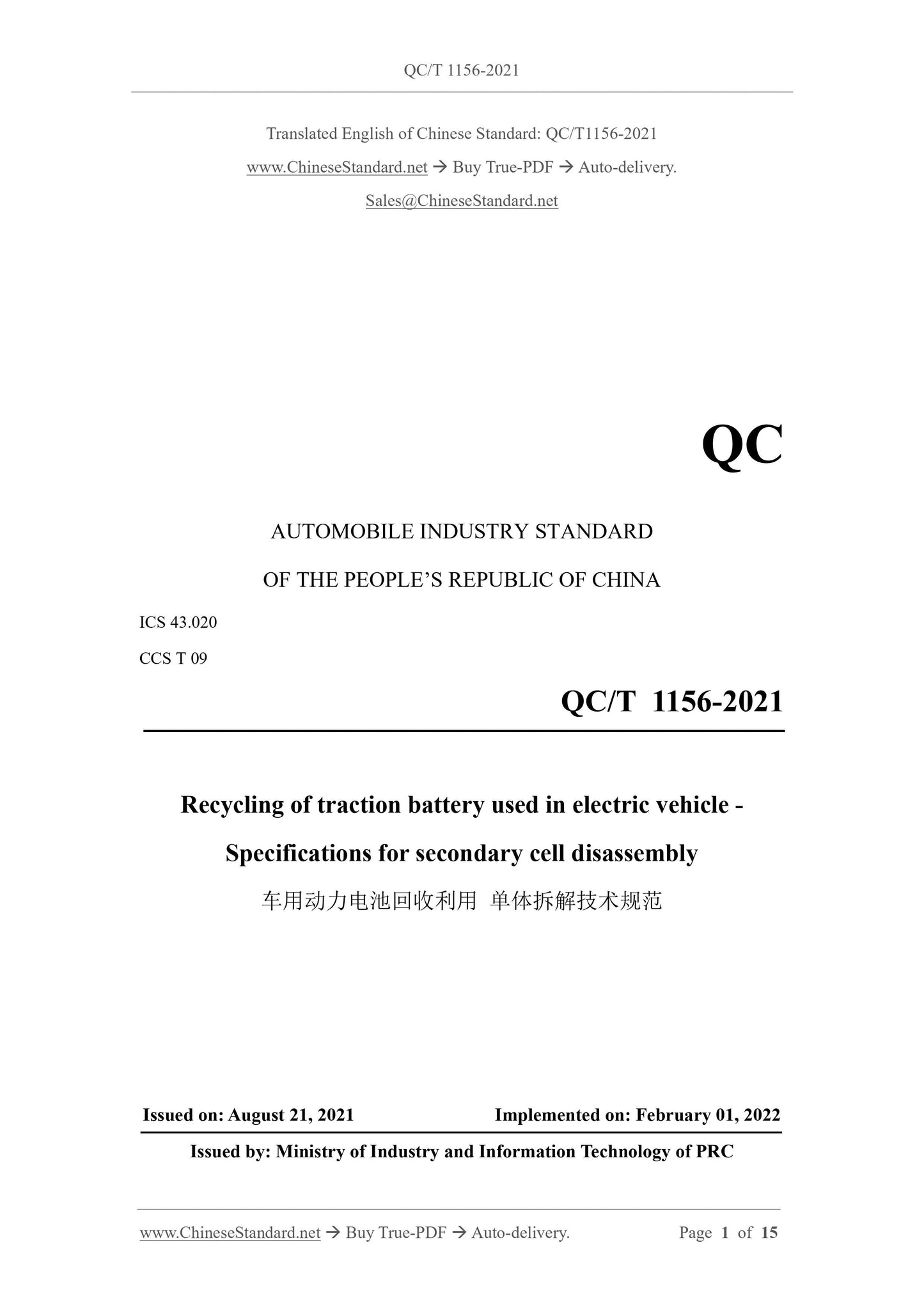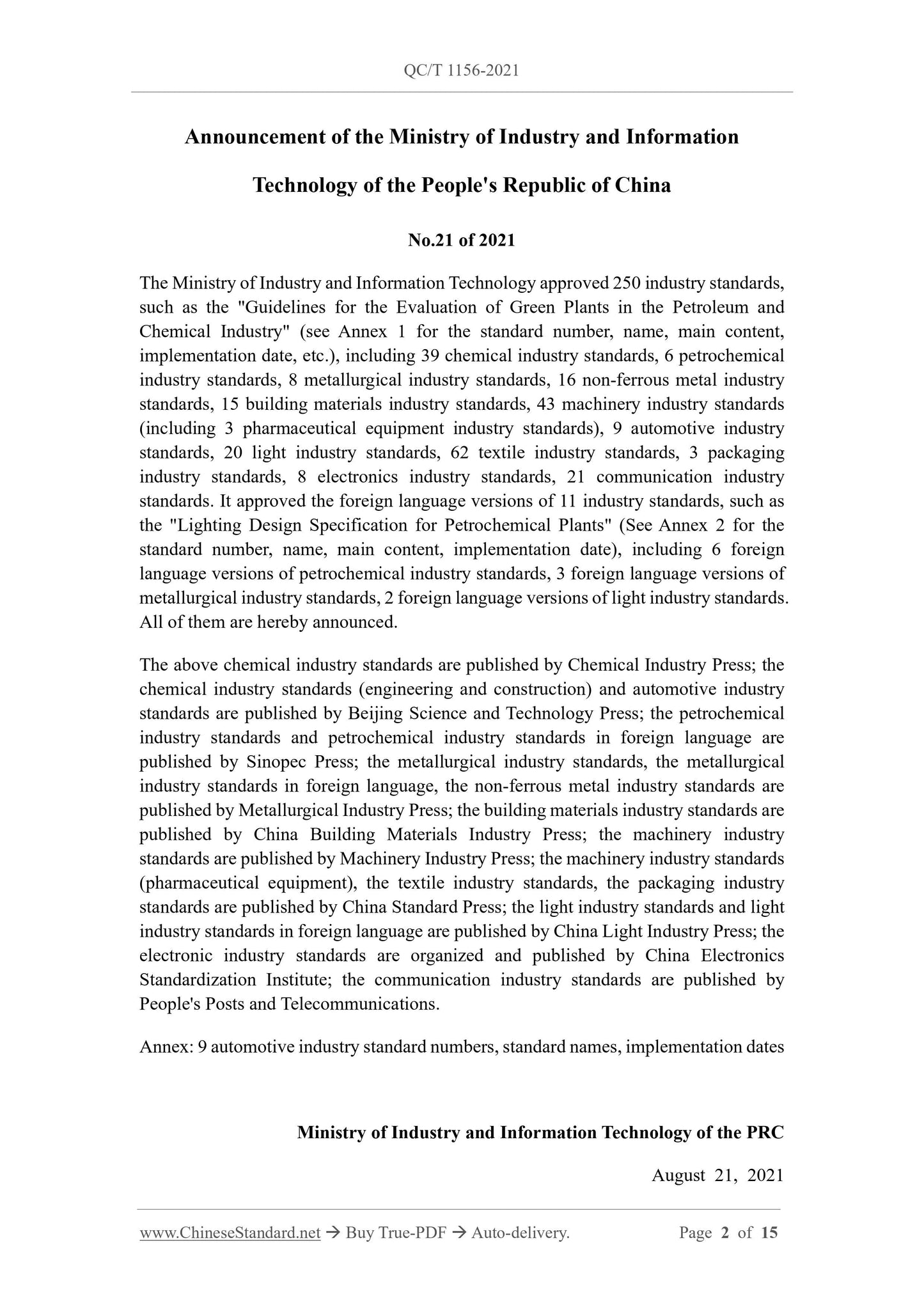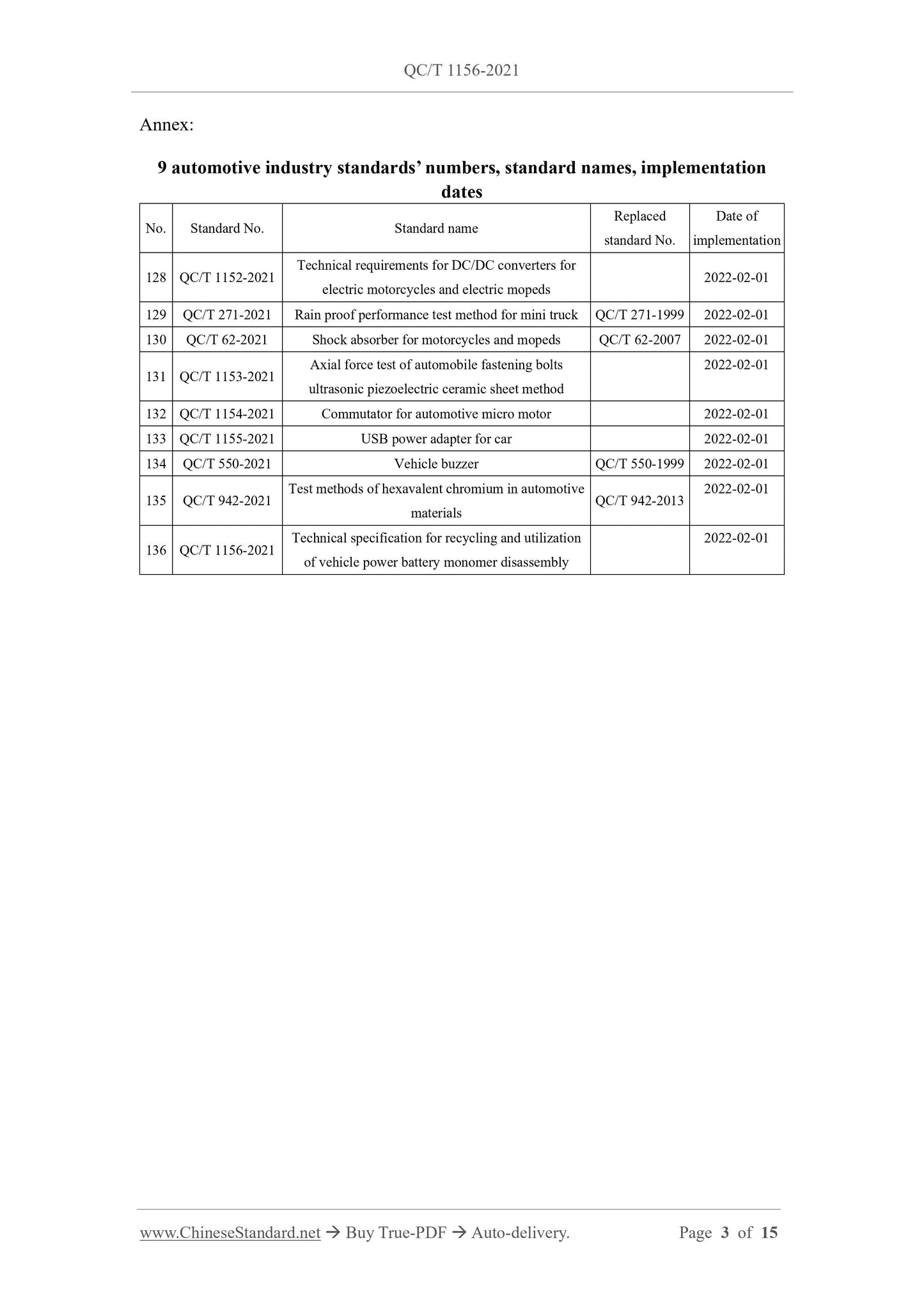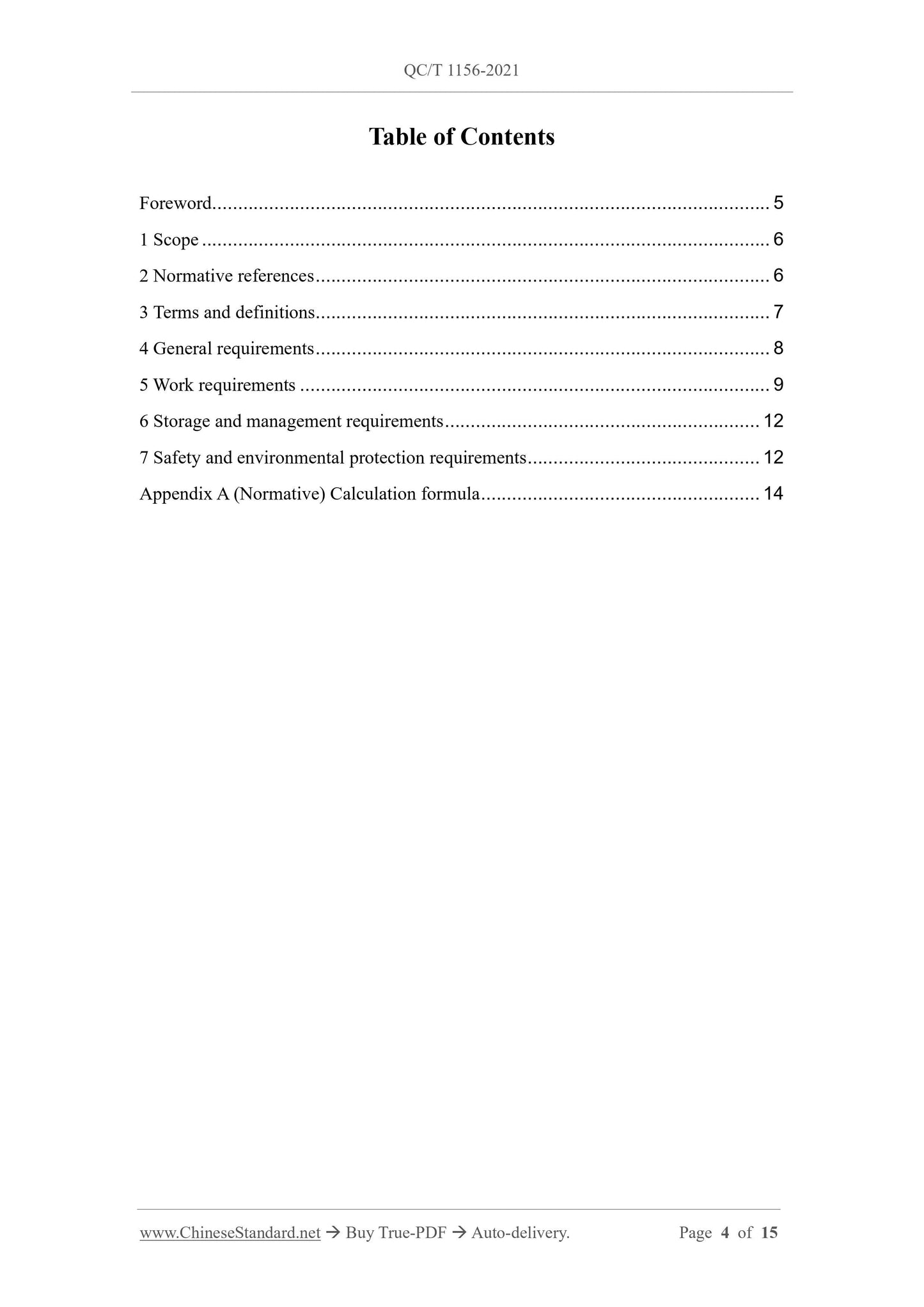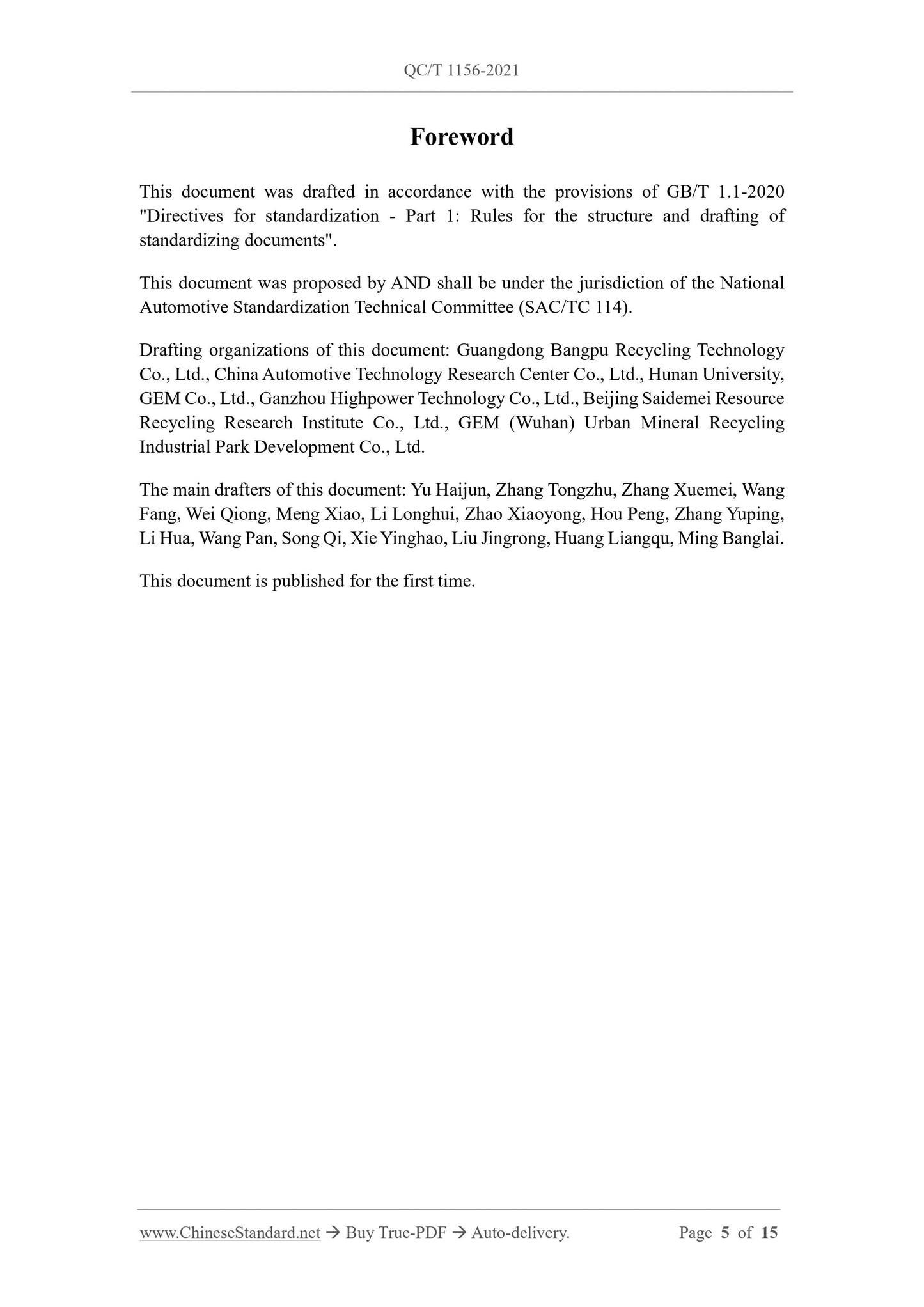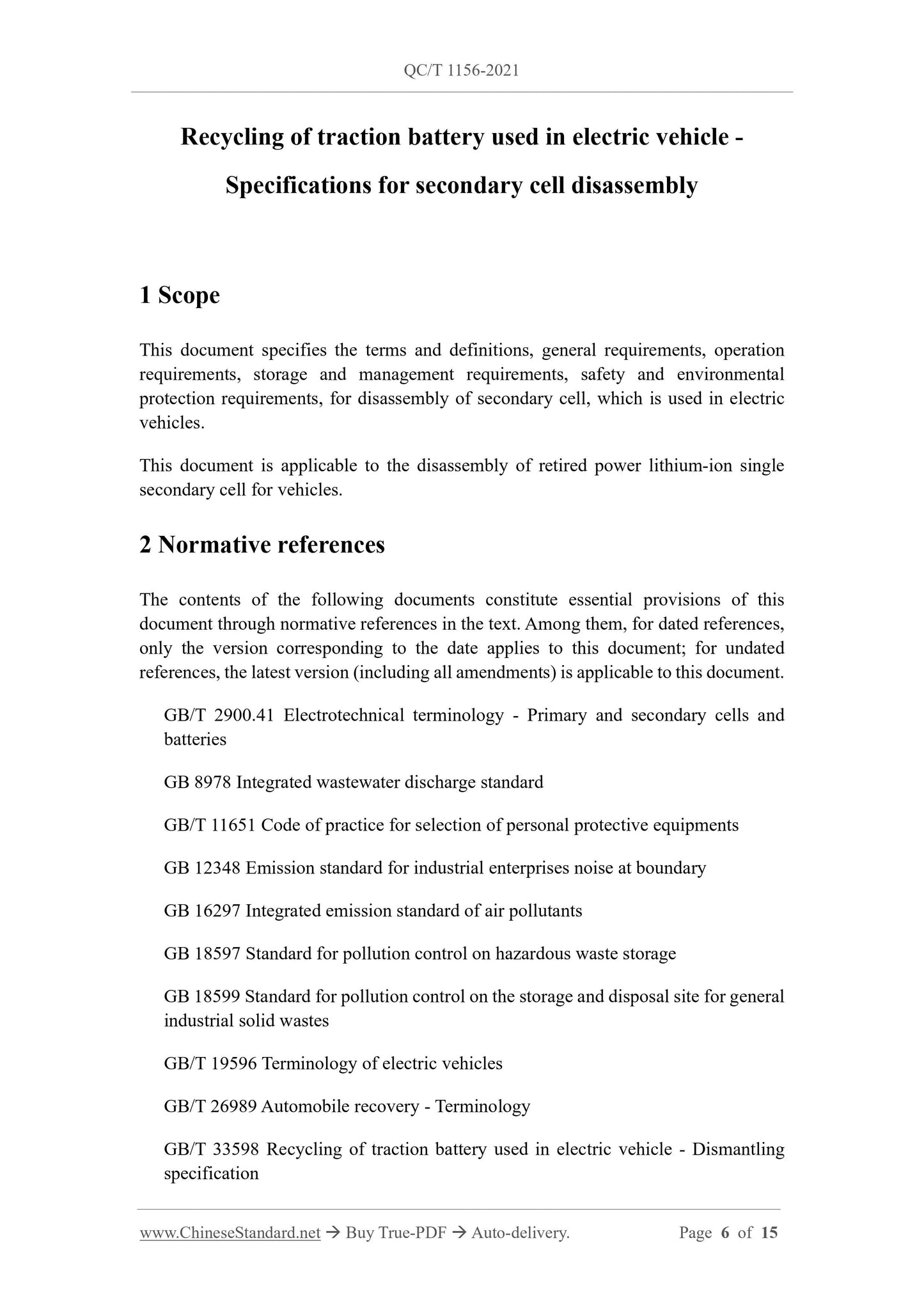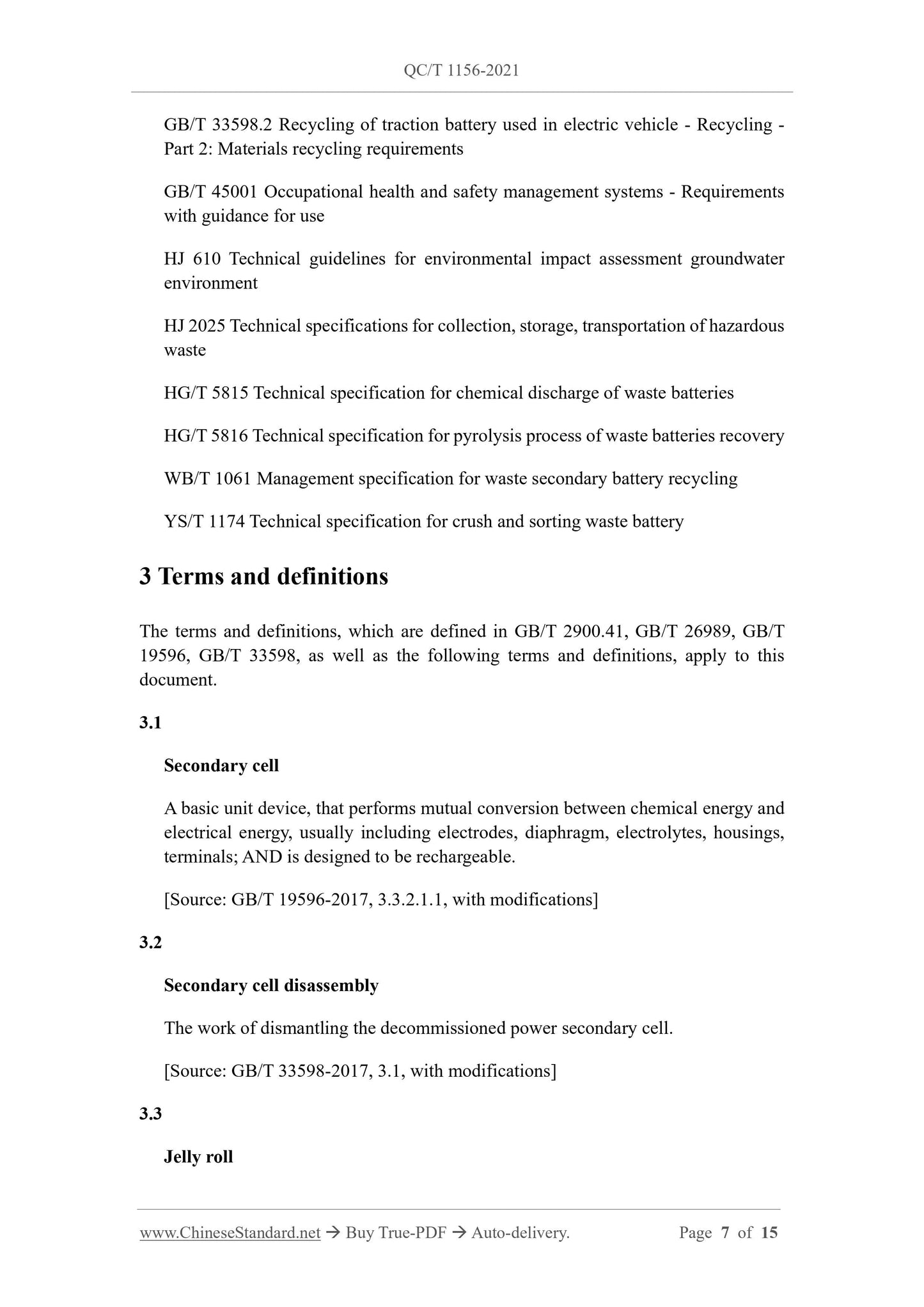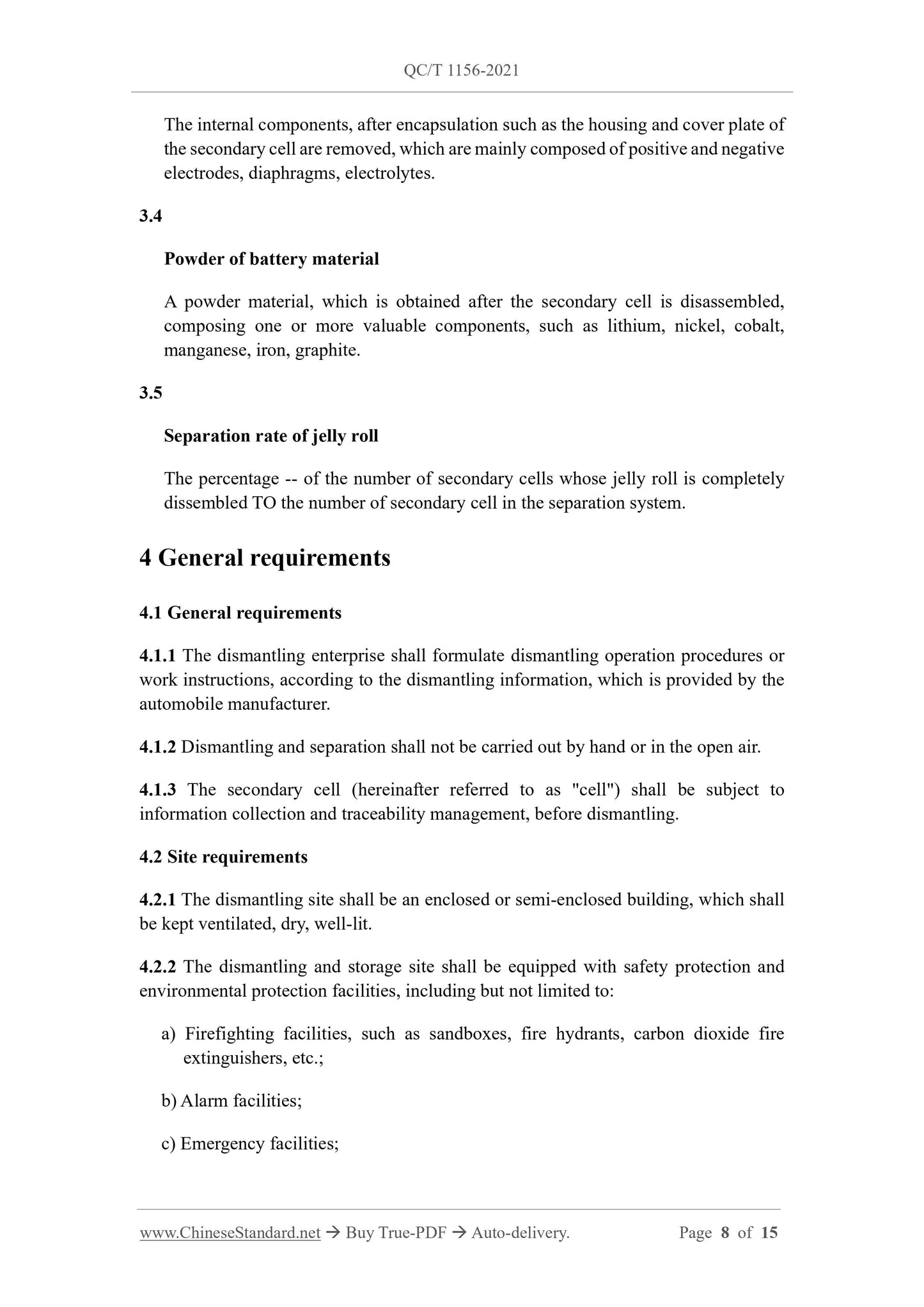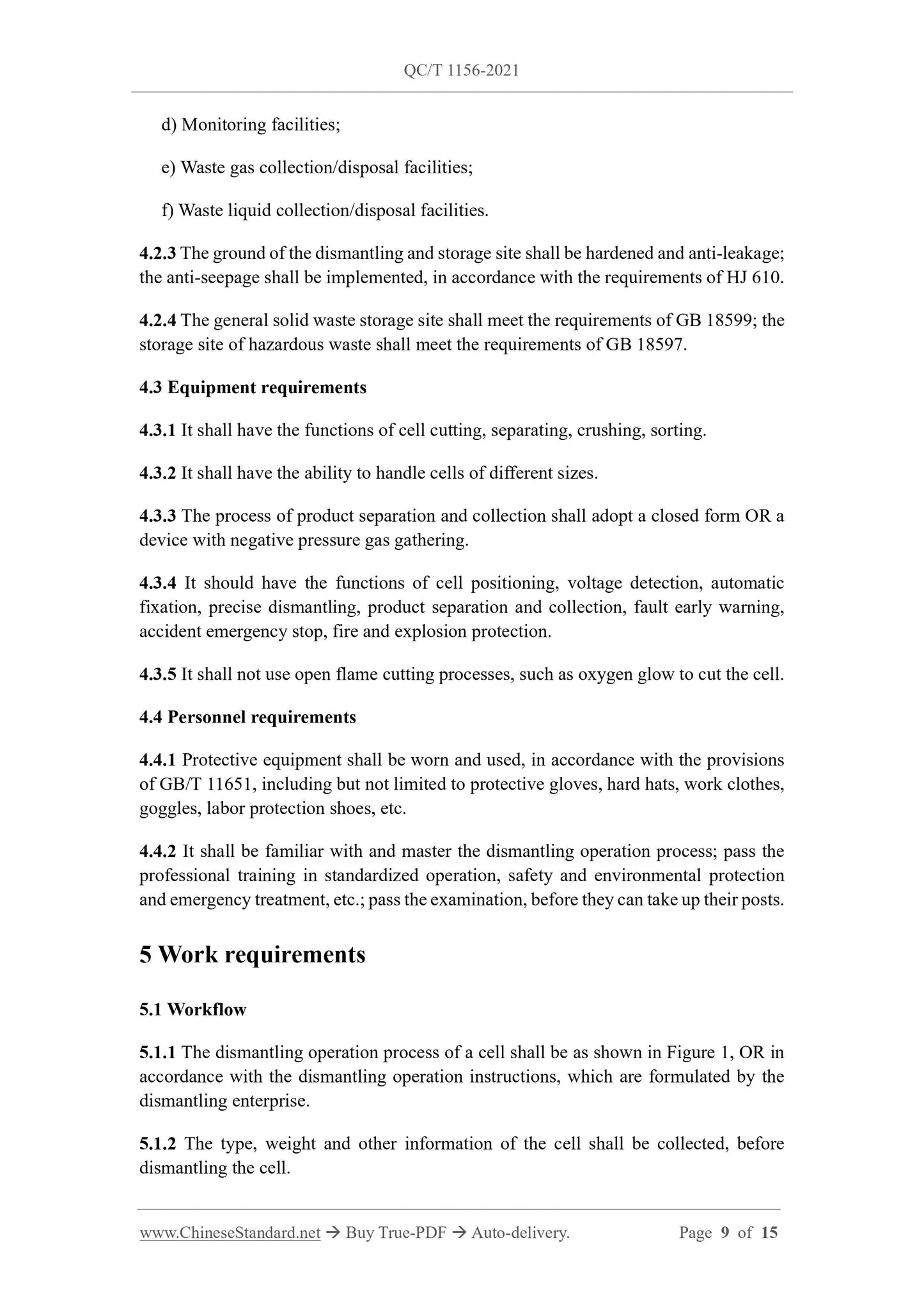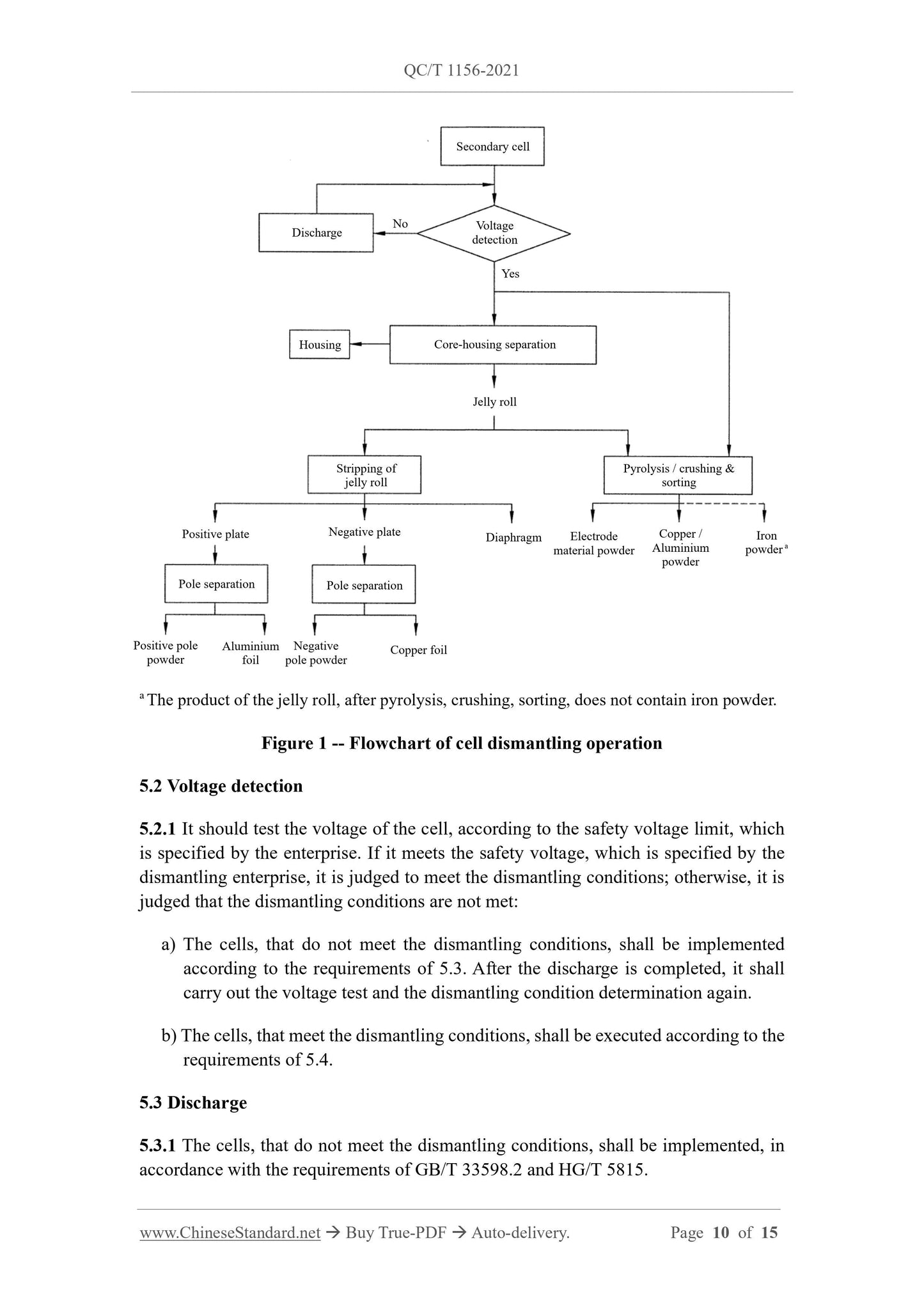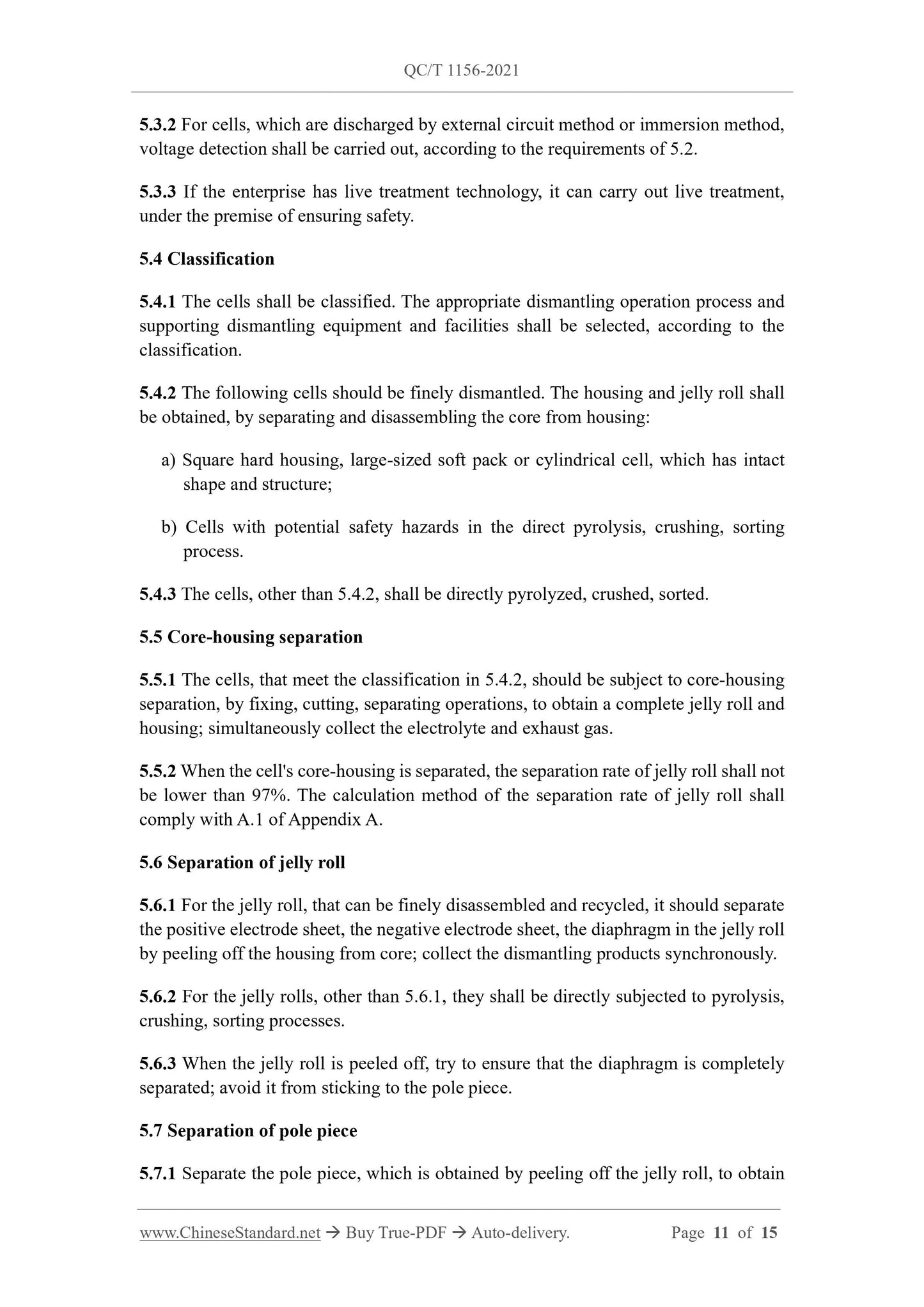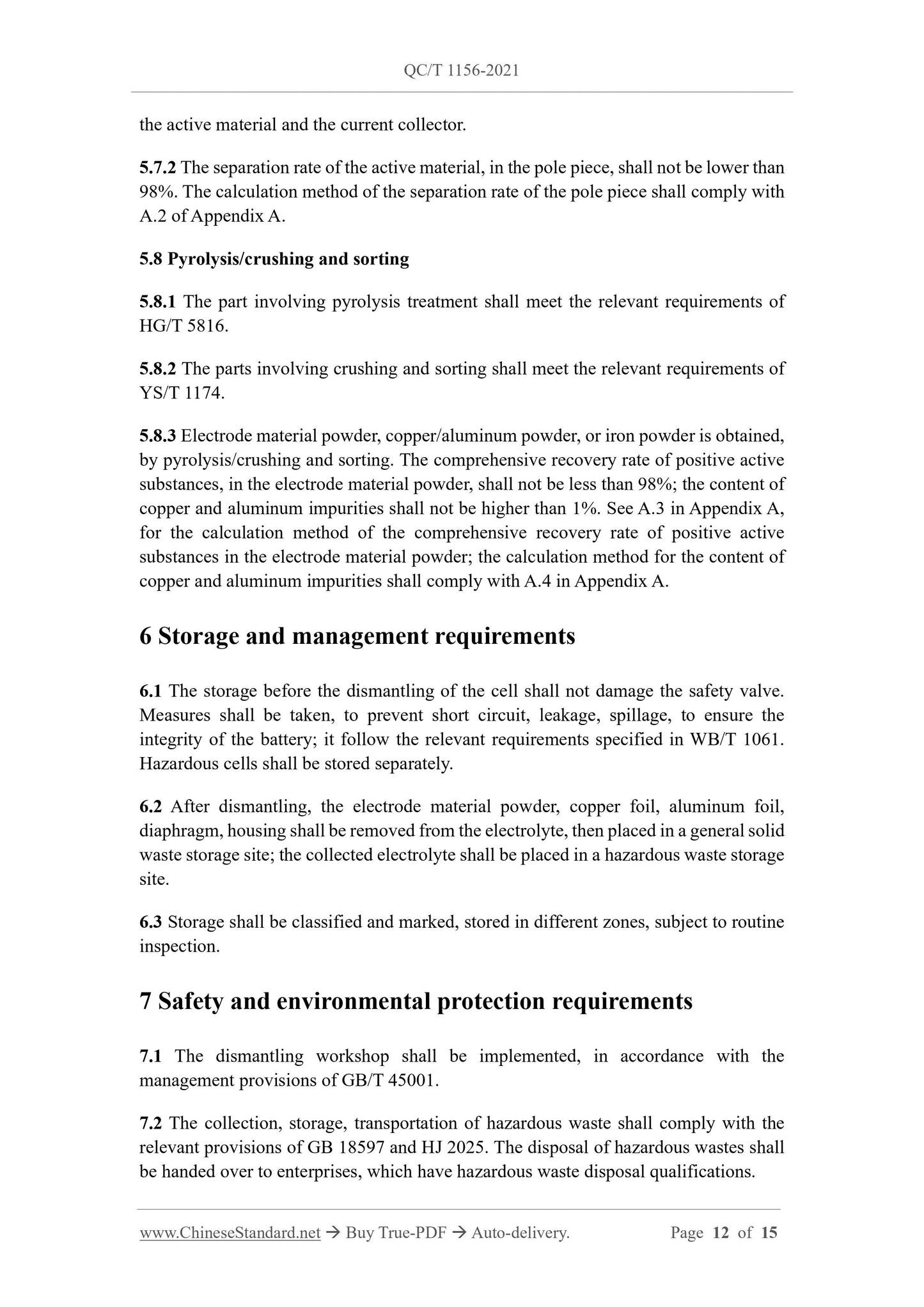1
/
/
12
PayPal, credit cards. Download editable-PDF & invoice in 1 second!
QC/T 1156-2021 English PDF (QCT1156-2021)
QC/T 1156-2021 English PDF (QCT1156-2021)
Normaalihinta
$185.00 USD
Normaalihinta
Alennushinta
$185.00 USD
Yksikköhinta
/
kohti
Toimituskulut lasketaan kassalla.
Noudon saatavuutta ei voitu ladata
Delivery: 3 seconds. Download true-PDF + Invoice.
Get QUOTATION in 1-minute: Click QC/T 1156-2021
Historical versions: QC/T 1156-2021
Preview True-PDF (Reload/Scroll if blank)
QC/T 1156-2021: Recycling of traction battery used in electric vehicle - Specifications for secondary cell disassembly
QC/T 1156-2021
AUTOMOBILE INDUSTRY STANDARD
OF THE PEOPLE’S REPUBLIC OF CHINA
ICS 43.020
CCS T 09
Recycling of traction battery used in electric vehicle -
Specifications for secondary cell disassembly
ISSUED ON: AUGUST 21, 2021
IMPLEMENTED ON: FEBRUARY 01, 2022
Issued by: Ministry of Industry and Information Technology of PRC
Table of Contents
Foreword ... 5
1 Scope ... 6
2 Normative references ... 6
3 Terms and definitions... 7
4 General requirements ... 8
5 Work requirements ... 9
6 Storage and management requirements ... 12
7 Safety and environmental protection requirements ... 12
Appendix A (Normative) Calculation formula ... 14
Recycling of traction battery used in electric vehicle -
Specifications for secondary cell disassembly
1 Scope
This document specifies the terms and definitions, general requirements, operation
requirements, storage and management requirements, safety and environmental
protection requirements, for disassembly of secondary cell, which is used in electric
vehicles.
This document is applicable to the disassembly of retired power lithium-ion single
secondary cell for vehicles.
2 Normative references
The contents of the following documents constitute essential provisions of this
document through normative references in the text. Among them, for dated references,
only the version corresponding to the date applies to this document; for undated
references, the latest version (including all amendments) is applicable to this document.
GB/T 2900.41 Electrotechnical terminology - Primary and secondary cells and
batteries
GB 8978 Integrated wastewater discharge standard
GB/T 11651 Code of practice for selection of personal protective equipments
GB 12348 Emission standard for industrial enterprises noise at boundary
GB 16297 Integrated emission standard of air pollutants
GB 18597 Standard for pollution control on hazardous waste storage
GB 18599 Standard for pollution control on the storage and disposal site for general
industrial solid wastes
GB/T 19596 Terminology of electric vehicles
GB/T 26989 Automobile recovery - Terminology
GB/T 33598 Recycling of traction battery used in electric vehicle - Dismantling
specification
The internal components, after encapsulation such as the housing and cover plate of
the secondary cell are removed, which are mainly composed of positive and negative
electrodes, diaphragms, electrolytes.
3.4
Powder of battery material
A powder material, which is obtained after the secondary cell is disassembled,
composing one or more valuable components, such as lithium, nickel, cobalt,
manganese, iron, graphite.
3.5
Separation rate of jelly roll
The percentage -- of the number of secondary cells whose jelly roll is completely
dissembled TO the number of secondary cell in the separation system.
4 General requirements
4.1 General requirements
4.1.1 The dismantling enterprise shall formulate dismantling operation procedures or
work instructions, according to the dismantling information, which is provided by the
automobile manufacturer.
4.1.2 Dismantling and separation shall not be carried out by hand or in the open air.
4.1.3 The secondary cell (hereinafter referred to as "cell") shall be subject to
information collection and traceability management, before dismantling.
4.2 Site requirements
4.2.1 The dismantling site shall be an enclosed or semi-enclosed building, which shall
be kept ventilated, dry, well-lit.
4.2.2 The dismantling and storage site shall be equipped with safety protection and
environmental protection facilities, including but not limited to:
a) Firefighting facilities, such as sandboxes, fire hydrants, carbon dioxide fire
extinguishers, etc.;
b) Alarm facilities;
c) Emergency facilities;
d) Monitoring facilities;
e) Waste gas collection/disposal facilities;
f) Waste liquid collection/disposal facilities.
4.2.3 The ground of the dismantling and storage site shall be hardened and anti-leakage;
the anti-seepage shall be implemented, in accordance with the requirements of HJ 610.
4.2.4 The general solid waste storage site shall meet the requirements of GB 18599; the
storage site of hazardous waste shall meet the requirements of GB 18597.
4.3 Equipment requirements
4.3.1 It shall have the functions of cell cutting, separating, crushing, sorting.
4.3.2 It shall have the ability to handle cells of different sizes.
4.3.3 The process of product separation and collection shall adopt a closed form OR a
device with negative pressure gas gathering.
4.3.4 It should have the functions of cell positioning, voltage detection, automatic
fixation, precise dismantling, product separation and collection, fault early warning,
accident emergency stop, fire and explosion protection.
4.3.5 It shall not use open flame cutting processes, such as oxygen glow to cut the cell.
4.4 Personnel requirements
4.4.1 Protective equipment shall be worn and used, in accordance with the provisions
of GB/T 11651, including but not limited to protective gloves, hard hats, work clothes,
goggles, labor protection shoes, etc.
4.4.2 It shall be familiar with and master the dismantling operation process; pass the
professional training in standardized operation, safety and environmental protection
and emergency treatment, etc.; pass the examination, before they can take up their posts.
5 Work requirements
5.1 Workflow
5.1.1 The dismantling operation process of a cell shall be as shown in Figure 1, OR in
accordance with the dismantling operation instructions, which are formulated by the
dismantling enterprise.
5.1.2 The type, weight and other information of the cell shall be collected, before
dismantling the cell.
5.3.2 For cells, which are discharged by external circuit method or immersion method,
voltage detection shall be carried out, according to the requirements of 5.2.
5.3.3 If the enterprise has live treatment technology, it can carry out live treatment,
under the premise of ensuring safety.
5.4 Classification
5.4.1 The cells shall be classified. The appropriate dismantling operation process and
supporting dismantling equipment and facilities shall be selected, according to the
classification.
5.4.2 The following cells should be finely dismantled. The housing and jelly roll shall
be obtained, by separating and disassembling the core from housing:
a) Square hard housing, large-sized soft pack or cylindrical cell, which has intact
shape and structure;
b) Cells with potential safety hazards in the direct pyrolysis, crushing, sorting
process.
5.4.3 The cells, other than 5.4.2, shall be directly pyrolyzed, crushed, sorted.
5.5 Core-housing separation
5.5.1 The cells, that meet the classification in 5.4.2, should be subject to core-housing
separation, by fixing, cutting, separating operations, to obtain a complete jelly roll and
housing; simultaneously collect the electrolyte and exhaust gas.
5.5.2 When the cell's core-housing is separated, the separation rate of jelly roll shall not
be lower than 97%. The calculation method of the separation rate of jelly roll shall
comply with A.1 of Appendix A.
5.6 Separation of jelly roll
5.6.1 For the jelly roll, that can be finely disassembled and recycled, it should separate
the positive electrode sheet, the negative electrode sheet, the diaphragm in the jelly roll
by peeling off the housing from core; collect the dismantling products synchronously.
...
Get QUOTATION in 1-minute: Click QC/T 1156-2021
Historical versions: QC/T 1156-2021
Preview True-PDF (Reload/Scroll if blank)
QC/T 1156-2021: Recycling of traction battery used in electric vehicle - Specifications for secondary cell disassembly
QC/T 1156-2021
AUTOMOBILE INDUSTRY STANDARD
OF THE PEOPLE’S REPUBLIC OF CHINA
ICS 43.020
CCS T 09
Recycling of traction battery used in electric vehicle -
Specifications for secondary cell disassembly
ISSUED ON: AUGUST 21, 2021
IMPLEMENTED ON: FEBRUARY 01, 2022
Issued by: Ministry of Industry and Information Technology of PRC
Table of Contents
Foreword ... 5
1 Scope ... 6
2 Normative references ... 6
3 Terms and definitions... 7
4 General requirements ... 8
5 Work requirements ... 9
6 Storage and management requirements ... 12
7 Safety and environmental protection requirements ... 12
Appendix A (Normative) Calculation formula ... 14
Recycling of traction battery used in electric vehicle -
Specifications for secondary cell disassembly
1 Scope
This document specifies the terms and definitions, general requirements, operation
requirements, storage and management requirements, safety and environmental
protection requirements, for disassembly of secondary cell, which is used in electric
vehicles.
This document is applicable to the disassembly of retired power lithium-ion single
secondary cell for vehicles.
2 Normative references
The contents of the following documents constitute essential provisions of this
document through normative references in the text. Among them, for dated references,
only the version corresponding to the date applies to this document; for undated
references, the latest version (including all amendments) is applicable to this document.
GB/T 2900.41 Electrotechnical terminology - Primary and secondary cells and
batteries
GB 8978 Integrated wastewater discharge standard
GB/T 11651 Code of practice for selection of personal protective equipments
GB 12348 Emission standard for industrial enterprises noise at boundary
GB 16297 Integrated emission standard of air pollutants
GB 18597 Standard for pollution control on hazardous waste storage
GB 18599 Standard for pollution control on the storage and disposal site for general
industrial solid wastes
GB/T 19596 Terminology of electric vehicles
GB/T 26989 Automobile recovery - Terminology
GB/T 33598 Recycling of traction battery used in electric vehicle - Dismantling
specification
The internal components, after encapsulation such as the housing and cover plate of
the secondary cell are removed, which are mainly composed of positive and negative
electrodes, diaphragms, electrolytes.
3.4
Powder of battery material
A powder material, which is obtained after the secondary cell is disassembled,
composing one or more valuable components, such as lithium, nickel, cobalt,
manganese, iron, graphite.
3.5
Separation rate of jelly roll
The percentage -- of the number of secondary cells whose jelly roll is completely
dissembled TO the number of secondary cell in the separation system.
4 General requirements
4.1 General requirements
4.1.1 The dismantling enterprise shall formulate dismantling operation procedures or
work instructions, according to the dismantling information, which is provided by the
automobile manufacturer.
4.1.2 Dismantling and separation shall not be carried out by hand or in the open air.
4.1.3 The secondary cell (hereinafter referred to as "cell") shall be subject to
information collection and traceability management, before dismantling.
4.2 Site requirements
4.2.1 The dismantling site shall be an enclosed or semi-enclosed building, which shall
be kept ventilated, dry, well-lit.
4.2.2 The dismantling and storage site shall be equipped with safety protection and
environmental protection facilities, including but not limited to:
a) Firefighting facilities, such as sandboxes, fire hydrants, carbon dioxide fire
extinguishers, etc.;
b) Alarm facilities;
c) Emergency facilities;
d) Monitoring facilities;
e) Waste gas collection/disposal facilities;
f) Waste liquid collection/disposal facilities.
4.2.3 The ground of the dismantling and storage site shall be hardened and anti-leakage;
the anti-seepage shall be implemented, in accordance with the requirements of HJ 610.
4.2.4 The general solid waste storage site shall meet the requirements of GB 18599; the
storage site of hazardous waste shall meet the requirements of GB 18597.
4.3 Equipment requirements
4.3.1 It shall have the functions of cell cutting, separating, crushing, sorting.
4.3.2 It shall have the ability to handle cells of different sizes.
4.3.3 The process of product separation and collection shall adopt a closed form OR a
device with negative pressure gas gathering.
4.3.4 It should have the functions of cell positioning, voltage detection, automatic
fixation, precise dismantling, product separation and collection, fault early warning,
accident emergency stop, fire and explosion protection.
4.3.5 It shall not use open flame cutting processes, such as oxygen glow to cut the cell.
4.4 Personnel requirements
4.4.1 Protective equipment shall be worn and used, in accordance with the provisions
of GB/T 11651, including but not limited to protective gloves, hard hats, work clothes,
goggles, labor protection shoes, etc.
4.4.2 It shall be familiar with and master the dismantling operation process; pass the
professional training in standardized operation, safety and environmental protection
and emergency treatment, etc.; pass the examination, before they can take up their posts.
5 Work requirements
5.1 Workflow
5.1.1 The dismantling operation process of a cell shall be as shown in Figure 1, OR in
accordance with the dismantling operation instructions, which are formulated by the
dismantling enterprise.
5.1.2 The type, weight and other information of the cell shall be collected, before
dismantling the cell.
5.3.2 For cells, which are discharged by external circuit method or immersion method,
voltage detection shall be carried out, according to the requirements of 5.2.
5.3.3 If the enterprise has live treatment technology, it can carry out live treatment,
under the premise of ensuring safety.
5.4 Classification
5.4.1 The cells shall be classified. The appropriate dismantling operation process and
supporting dismantling equipment and facilities shall be selected, according to the
classification.
5.4.2 The following cells should be finely dismantled. The housing and jelly roll shall
be obtained, by separating and disassembling the core from housing:
a) Square hard housing, large-sized soft pack or cylindrical cell, which has intact
shape and structure;
b) Cells with potential safety hazards in the direct pyrolysis, crushing, sorting
process.
5.4.3 The cells, other than 5.4.2, shall be directly pyrolyzed, crushed, sorted.
5.5 Core-housing separation
5.5.1 The cells, that meet the classification in 5.4.2, should be subject to core-housing
separation, by fixing, cutting, separating operations, to obtain a complete jelly roll and
housing; simultaneously collect the electrolyte and exhaust gas.
5.5.2 When the cell's core-housing is separated, the separation rate of jelly roll shall not
be lower than 97%. The calculation method of the separation rate of jelly roll shall
comply with A.1 of Appendix A.
5.6 Separation of jelly roll
5.6.1 For the jelly roll, that can be finely disassembled and recycled, it should separate
the positive electrode sheet, the negative electrode sheet, the diaphragm in the jelly roll
by peeling off the housing from core; collect the dismantling products synchronously.
...
Share
